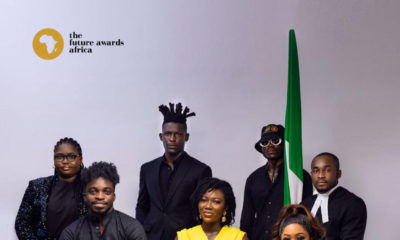Features
You Should Read Our Conversation With the Photographer Behind this Iconic #EndSARS Shot
You must have seen the photo on your timeline, your friend’s WhatsApp status. The one with a woman clad in grey hijab, black sneakers, brown bag, a face mask and her clenched fist raised high. There are other protesters behind her with arms locked in each other’s, standing in solidarity with one voice.
That woman is Aisha Yesufu. The name may be familiar. She is one of the strong voices in the Bring Back Our Girls activism, and has been very vocal about governance in Nigeria.
We spoke to Victor Odiba of ShoeBox Photography, the photographer behind the iconic photo, which has somewhat become the symbol for the fight against police brutality, and he shares with us what he was trying to capture when he took the now-viral photo.
Here’s the conversation:
Did you know, in the moment, how powerful the image was going to be?
I would say in that moment, what we all knew was that at any second the tear gas would be fired at us. Everyone was ready! I knew If I could capture our courage and fearlessness, that would definitely be something. But I didn’t know I got anything awe inspiring or powerful until I got home and reviewed the images. Even then, I knew “I” liked it and it resonated with me but I couldn’t have predicted how other people would respond to it.
How did you feel being a part of the protest?
It is something that comes naturally to me. I mean, my tribal name is “Akagwu”. It means “warrior”. My mother is a fighter, the women in my family have always been people that challenge the status quo. Nigerians in general are very resilient people, and when we align towards a “sensible” collective goal the energy that comes from being part of it is almost addictive. I really love the Nigerian spirit. I didn’t see how I would have been absent.
How is it like covering the #EndSARS protests as a photographer?
Every time I think about my history or even the history of Nigeria as a whole, I wish we had more pictures or drawings, or something that could have helped my very graphic mind. I know too well the importance of media. Especially hundreds of years from now.
As a photographer I had only one mission, I wanted to be able to translate the emotion and energy I was feeling to the mind of whoever looked at the pictures. Now from my experience, I know its usually a long shot, but I was prepared to do a bit more and see what comes out of it. You know photographers are always ready to go the extra mile, ever ready for the right moment, waiting for the perfect shot. We’re like snippers.
How does it feel seeing the image being used so frequently to tell the story of the protests?
Well, it’s not the Guernica by Pablo Picasso or anything, but I’m really excited about what it has come to represent. The idea that the Nigerian youth can find a collective voice, and even use my image to represent that Idea is such a privilege to me. I was so overwhelmed. I didn’t event realise I wasn’t getting credit until later. As much as possible I don’t want to distract from the movement. The #EndSars Movement is very unique, and ironically “it belongs to everybody and it belongs to NOBODY” if you know what I mean.
See more photos from the Abuja protests:

























